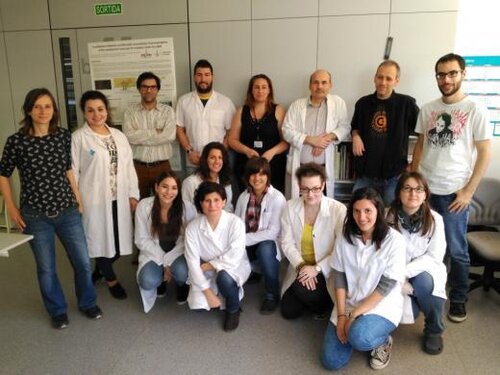IRB Lleida and UDL describe a new mechanism that regulates the invasive capacity of stem cells
The research explains how the protein cyclin D1 regulates the process of cell invasion and the importance of this mechanism in tumor invasion
Lleida, May 25, 2016
Researchers of the groups of Cell Cycle and Oncopatologia the Biomedical Research Institute of Lleida (IRBLLEIDA) and the University of Lleida (UDL), in collaboration with the Department of Pathology at the University Hospital Arnau de Vilanova in Lleida (HUAV) have described a new molecular mechanism that signals and activates the process of cell invasion. The results highlight the importance of the use of inhibitors of the activity of the cyclin D1 protein in cancer therapy. The results are published in Nature Communications and Oncotarget, renowned international journals in the fields of oncology and molecular biology. These works are also part of the thesis of Noel P. Fusté, held in the UDL. Alicia Cuello of Merigó Foundation has funded part of the research through a grant.
The ability to invade cells is key to the formation of tissues and organs during embryonic development. The invasion process is controlled by different mechanisms that promote migration of cells through the extracellular matrix. In adults these processes are still very important for the functioning of the body, for example during wound healing. Unfortunately, the alteration of the invasive capacity of cells can have dire consequences for the organism. For example, the cells of a solid tumor can invade surrounding tissues and even reach the blood vessels leading to metastasis.
The research groups IRBLleida-UDL shows how the protein cyclin D1 promotes cell invasion through a new molecular pathway. This protein is a key regulator of the cell cycle and is encoded by an oncogene, which has been amplified in a large number of tumors of different origin and type. Normally, the protein is found in the cell nucleus and regulates the expression of genes involved in the control of cell proliferation. In contrast, this study shows that Cyclin also found in the cell membrane and activates a group of proteins involved in the processes of cell adhesion and invasion. Accordingly, it has been found that the accumulation of a large quantity of the cyclin D1 protein in the membrane of endometrial tumor cells causes an increased invasive capacity and the formation of metastasis. In addition, it was observed that tumor cells present in the tumor regions invasive endometrial, breast, colon and prostate cancer show high levels of cyclin D1 associated with the membrane. The results highlight the importance of the use of inhibitors of the activity of this protein in cancer therapy.
Groups ular Cell Cycle and Cancer Pathology
The authors of the Cell Cycle Group CEMELA are Tania, Neus Colomina, Ferrezuelo Francisco, Pedraza Snow, Noel Perez, Marta Rafel, Marc Tarrés, Eloi and Jordi Torres Garí. Cell Cycle Group studies the mechanisms that regulate the internal division of eukaryotic cells. In particular, it analyzes: dependent mechanisms of SMC complex and SUMO to ensure genome stability during the cycle in response to DNA damage and the mechanisms involved in the control of the input cycle and its relationship the polarity, cell adhesion and migration.
The authors are Oncologic Pathology Group Esmeralda Castelblanco, Isidre Felip Maria Santacana Sonia Gatius Judith Pallares, Cristina watching, Xavier and Xavier Matias-Guiu Dolcet. Pathology Group studies the molecular alterations of cancers of the endometrium, thyroid and skin correlated with clinical and pathological characteristics. The Group operates in the Research Laboratory of the University Hospital Arnau de Vilanova (HUAV).







